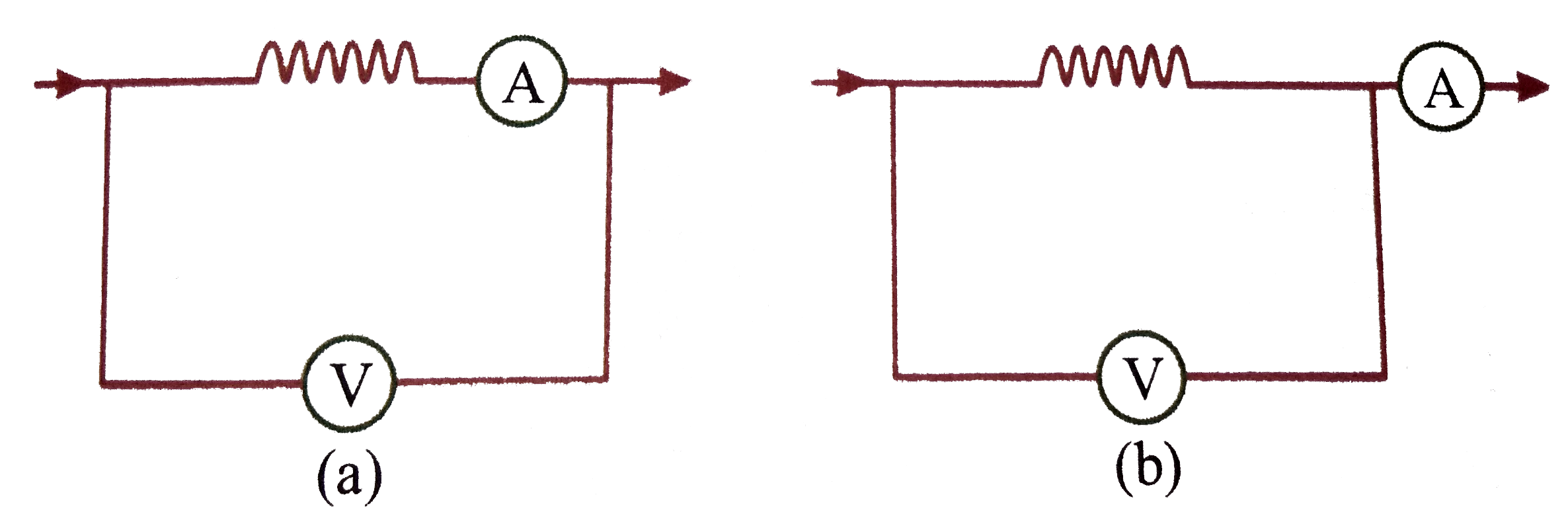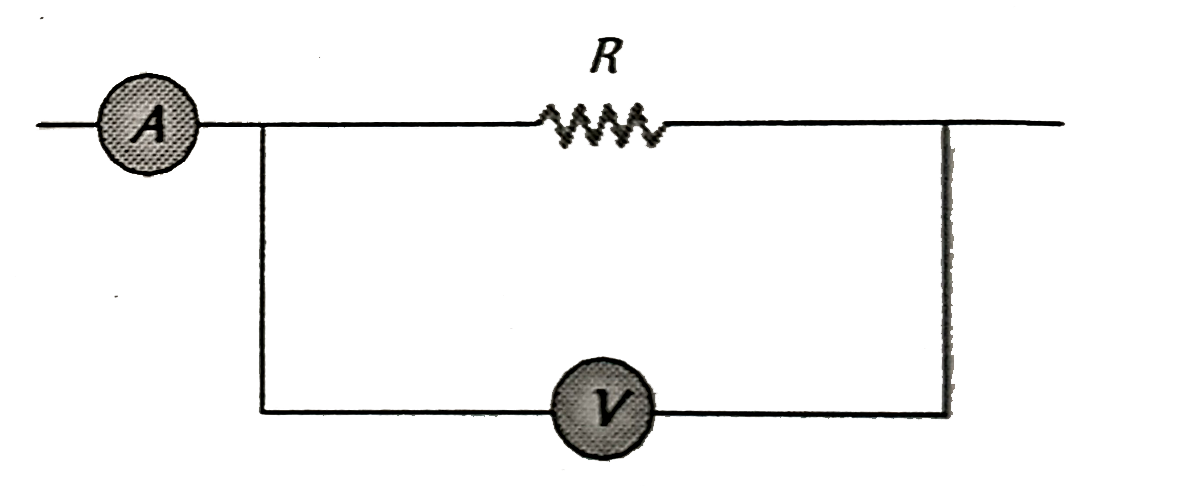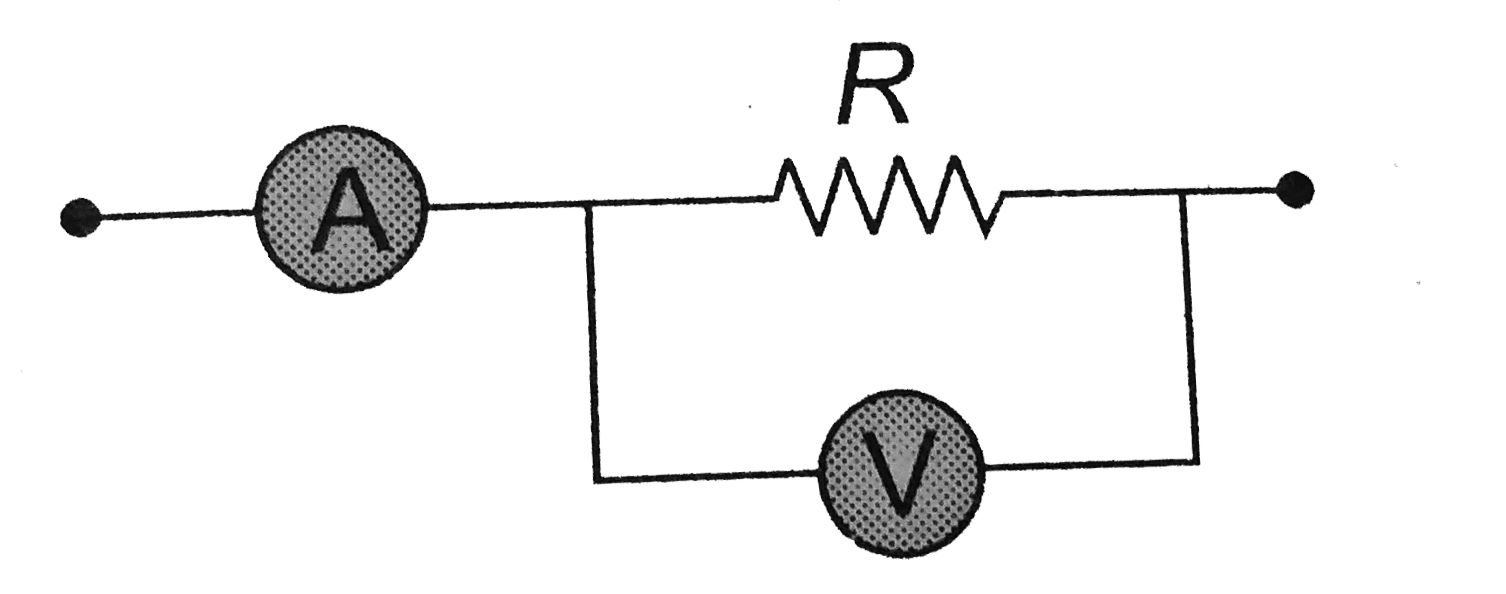In the, Ohm's law experiment ot find resistance of unknown resistor R, the arrangement is as shown. The resistance measured is given by Rmeasured=ViV= voltage reading of voltmeter. i=current reading of ammeter. The ammeters and the voltmeter used are not ideal, and have resistance RA and RV respectively. For arrangement shown, the meausred resistance is

R+RV
R+RA
RvR+Rv
RVR+RV+RA
The correct Answer is:B
Potential drop →V=i(R+RA)
Vi=R+RA=Rmeaured

Topper's Solved these Questions
- TEST PAPERSBook:ALLENChapter:TEST PAPERSExercise:PAPER 3
Explore 100 Videos
- TEST PAPERSBook:ALLENChapter:TEST PAPERSExercise:Part-1 Physics
Explore 15 Videos
- TEST PAPERSBook:ALLENChapter:TEST PAPERSExercise:MATHS
Explore 18 Videos
- TEST PAPER 4Book:ALLENChapter:TEST PAPER 4Exercise:PHYSICS
Explore 45 Videos
- UNIT & DIMENSIONS, BASIC MATHS AND VECTOR Book:ALLENChapter:UNIT & DIMENSIONS, BASIC MATHS AND VECTOR Exercise:Exercise (J-A)
Explore 7 Videos
Similar Questions
Knowledge Check
In the, Ohm's law experiment to find resistance of unknown resistor R, following two arrangement (a) and (b) are possible.

The resistance measured is given by
Rmeasured=Vi
V= voltage reading of voltmeter, i= current Reading of ammeter.
But unfortunately the ammeters and voltmeter used are not ideal, but having resistance RA and RV respectively.
For arrangement (b), the measured resistance isAR+RVBR+RACRRVR+RVDRRVR+RV+RAIn the, Ohm's law experiment to find resistance of unknown resistor R, following two arrangement (a) and (b) are possible.

The resistance measured is given by
Rmeasured=Vi
V= voltage reading of voltmeter, i= current Reading of ammeter.
But unfortunately the ammeters and voltmeter used are not ideal, but having resistance RA and RV respectively.
For arrangement (s), the measured resistance isAR+RVBR+RACRRVR+RVDRRVR+RV+RAIn the, Ohm's law experiment to find resistance of unknown resistor R, following two arrangement (a) and (b) are possible.

The resistance measured is given by
Rmeasured=Vi
V= voltage reading of voltmeter, i= current Reading of ammeter.
But unfortunately the ammeters and voltmeter used are not ideal, but having resistance RA and RV respectively.
You are given two resistor X and Y. Whose resistance is to be determined , using an ammeter of RA=0.5Ω and a voltmeter of RV=20KΩ. It is known that X is in range of a few Ohm and Y is in range of several kilo ohm. Which of the circuit is preferable to measure X and Y-Resistor CircuteAx→(a), y→(b)Bx→(b), y→(a)Cx→(a), y→(a)Dx→(b), y→(b)
The ammeter A reads 2A and the voltmeter V reads 20V, the value of resistance R is (Assuming finite resistance's of ammeter and voltmeter)

View SolutionIn the Ohm'slaw experiment to find resistance of unknown resistor R following arrangements (a) and (b) are possible The resistance measured is given by
Rmeasured=Vi
V = voltage reading of voltmeter I = current Reading of ammeter But unfortunately the ammeters and voltmeter used are not ideal but having resistance RA and Rv respect tively

Yor are given two unknown resistors X and Y These resistances are to be determind using an ammeter of RA=0.5Ω and a voltmeter of Rv=20kΩ It is known that X is in range of a few ohms and Y is in the range of several kilo ohm's Which circuit is perferable to measure X and Y
ResistorCircuitx(a)y(b) .
View SolutionIn the circuit shown below, the ammeter A reads 5 A and the voltmeter V reads 20 V The correct value of resistance R is

View SolutionIn the circuit shown the reading of ammeter and voltmeter are 4A and 20V respectively. The meters are non ideal, then R ia

View SolutionIf the ammeter in the given circuit shown in the diagram reads 2A, the resistance R is

View Solution



